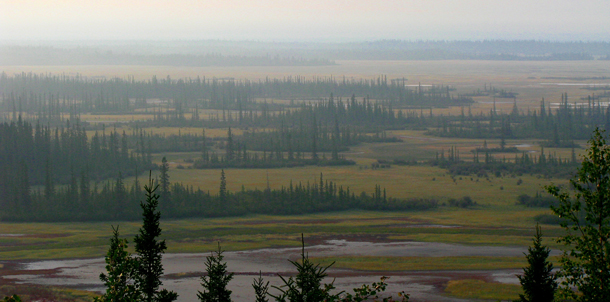BirdNote®: Whooping Cranes
Air Date: Week of May 4, 2018

A Whooping Crane spreads its wings in the dewy grass. (Photo: IUCNweb CC)
The world’s remaining totally wild flock of critically endangered Whooping Cranes dances at its summer home in Canada’s Wood Buffalo National Park. Michael Stein takes us to there in today’s BirdNote®.
Transcript
CURWOOD: BirdNote today takes us to the second largest national park in the world. It’s over 17,000 square miles and is a UNESCO world heritage site. And as Michael Stein tells us it’s the summer home for America’s tallest bird.
.
BirdNote®
Wood Buffalo National Park – Birthplace of Whooping Cranes
[Calls of Whooping Cranes]
In the Canadian north, where Alberta meets The Northwest Territories, lies the huge Wood Buffalo National Park. Here the Peace and Athabasca Rivers run through fescue grasslands, boreal forests, and wetlands of international significance. Here one of the world’s most endangered birds, the Whooping Crane, comes to dance, nest, and raise its young.
[Calls of Whooping Cranes]
“I like to describe Wood Buffalo National Park as a place of superlatives,” says park superintendent Rob Kent. “Visitors can see pristine ecosystems, 5,000 bison, 150-pound wolves, the largest freshwater delta in North America, and fire and ice that shape things on a grand scale.”
[wolf howl followed by wetland]

Whooping Cranes nest in the largest freshwater delta in North America, located in Wood Buffalo National Park. (Photo: Drew Brayshaw, Flickr CC BY-NC 2.0)
The world’s last completely wild flock of Whooping Cranes – about 275 – returns in spring to a vast mosaic of marshes and shallow ponds. In summer, with 20 hours of daylight, you can almost hear the explosive growth of plants and insects. [Insects] The insects become food for the dragonfly larvae that become food for the birds.
When summer ends and the juveniles are able to fly, the cranes fly 2,700 miles to winter on the Gulf Coast of Texas. I’m Michael Stein.
[Calls of Whooping Cranes]
###
Written by Chris Peterson with special thanks to Rob Kent, WBNP Superintendent
Bird sounds provided by The Macaulay Library of Natural Sounds at the Cornell Lab of Ornithology, Ithaca, New York. Calls of Whooping Cranes [2748 and 2749] recorded by George Archibald; honeybee and other insects [60446] recorded by V.J. Ketner.
Nature SFX sounds recorded by Gordon Hempton of Quietplanet.com. #18 stream flowing, #63 coniferous forest with insects, ravens and other birds; wetland pond with morning birdsong #97
BirdNote’s theme music was composed and played by Nancy Rumbel and John Kessler.
Producer: John Kessler
Executive Producer: Chris Peterson
© 2005-2018 Tune In to Nature.org April 2018 Narrator: Michael Stein
Reference: www.parkscanada.gc/woodbuffalo
https://www.birdnote.org/show/wood-buffalo-national-park-birthplace-whooping-cranes
CURWOOD: Dance on over to our website, loe dot org for pictures and to learn the Whooping crane two-step.
[CALLS OF WHOOPING CRANES]
Links
“Wood Buffalo National Park – Birthplace of Whooping Cranes” on the BirdNote® website
Living on Earth wants to hear from you!
Living on Earth
62 Calef Highway, Suite 212
Lee, NH 03861
Telephone: 617-287-4121
E-mail: comments@loe.org
Newsletter [Click here]
Donate to Living on Earth!
Living on Earth is an independent media program and relies entirely on contributions from listeners and institutions supporting public service. Please donate now to preserve an independent environmental voice.
NewsletterLiving on Earth offers a weekly delivery of the show's rundown to your mailbox. Sign up for our newsletter today!
 Sailors For The Sea: Be the change you want to sea.
Sailors For The Sea: Be the change you want to sea.
 The Grantham Foundation for the Protection of the Environment: Committed to protecting and improving the health of the global environment.
The Grantham Foundation for the Protection of the Environment: Committed to protecting and improving the health of the global environment.
 Contribute to Living on Earth and receive, as our gift to you, an archival print of one of Mark Seth Lender's extraordinary wildlife photographs. Follow the link to see Mark's current collection of photographs.
Contribute to Living on Earth and receive, as our gift to you, an archival print of one of Mark Seth Lender's extraordinary wildlife photographs. Follow the link to see Mark's current collection of photographs.
 Buy a signed copy of Mark Seth Lender's book Smeagull the Seagull & support Living on Earth
Buy a signed copy of Mark Seth Lender's book Smeagull the Seagull & support Living on Earth

